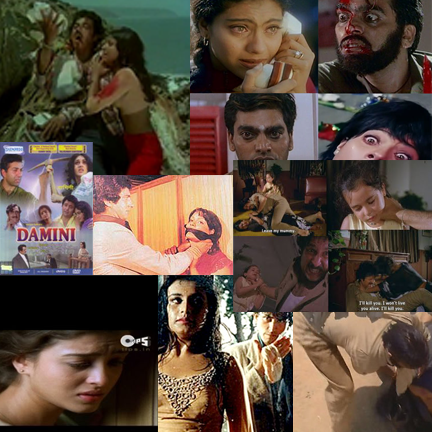1980 (Insaaf ka Tarazu) 1981(Ek duje ke liye) 1982 (Prem Rog) 1983 (Andha Kanoon) 1984 (Andar Bahar) 1985 (Bhavani Junction) 1986 (Akhari Rastaa) 1987 (Dance Dance) 1988 (Kudrat ka Kanoon) 1989 (Zakhmi Aurat) 1990 (Police Public) 1991 (Phool Bane Angarey) 1992 ( Anjaam, Jigar) 1993 (Damini) 1994 (Mohra, Bandit Queen) 1995 ( None) 1996 (Agni Sakshi, Raja ki ayegi baarat) Marital rape and marry your rapist 1997 ( Darmiyaan, Transgender rape, Mrityudand ( Caste based exploitative rape and attempt on married woman) 1998 (Dushman) 1999 ( None) 2000 ( Humara dil aapke paas hai) 2001 ( Aks, Lajja) 2002 ( Jaani Dushman, Koi mere dil se poonche)
The generation currently doing candle light vigils and marches across the nation is from the decade where social cinema was defined by helpless social malice and cinematic justice. There were films on blackmarketing, unruly politicians, corporate and labor injustice and the women centric “RAPE” films. What all of them had in common was injustice as the theme, what they also had in common was the climax where the villain was killed, swarmed, castrated, lynched and so on. As much as the cinematic appeal of these films may wow us and reflect in the societal solution for the delhi rape victim, they all are CINEMA.
The theme that runs common amongst all the above films until 2002 was the victim either died or killed herself, was ostracized, was exploited by the police within, law and justice and only one out of all the above films had justice where the sociological pressure of justice was so high that the woman, DAMINI, had to lose her family, in-laws, friends, even her and her husband’s life was threatened. These are examples of the films where rapes happened and in the absence of justice the women became vigilante, their brother’s became heroes, their husband’s became warriors or simply the end was “IZZAT LUT GAYI” Which mean “I have no respect left”.
Whether these movies reflected reality at the time, or deepened our social prejudices is up for debate. However, their impact on how we perceive rape, victims, perpetrators as well as our law and order system around rape is undeniable.
On one hand, where some movies glorify rape in many ways, others repress all possible natural expression of sexuality in almost unnatural ways.
Our gods do not have sex, even though we worship SHIVA’s penis and PARVATI’s vagina’s unison in the form of shivalinga. In Mahabharata, the epic made by BR Chopra, neither humans nor Gods were shown becoming intimate. Does this creation of curiosity actually make it more interesting/titillating for our audiences?
Our movies show women marrying their rapist, being enamored by the bad boy who is eventually a hero, fighting over the baddest boy in town, and being won over by superficial temporary change. Most movies glorify the savior, and show the ‘heroine’ being raped or troubled to give the ‘hero’ an opportunity to save the day and win her heart. I wondered why Bollywood was silent in this last week where India needed change, why didn’t a Bollywood guy/girl pay a good lawyer to find loopholes in our system to help the civil society put an informed change. I guess this is what Bollywood does, make unresearched, biased and sometimes socially harmful films, even if they are historical, to suit the pop-corn sensibility.
